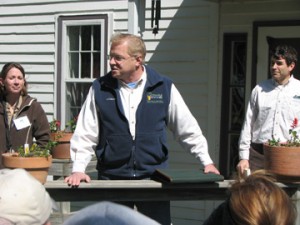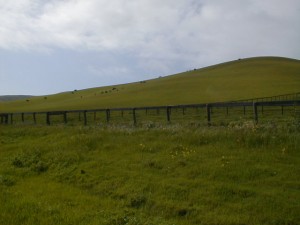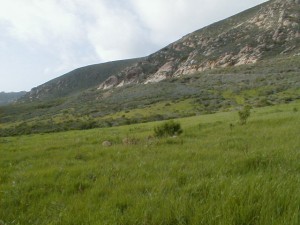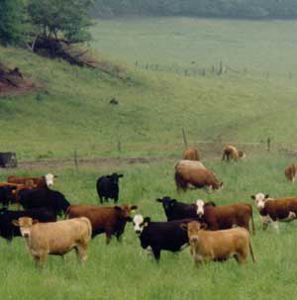See link at bottom for the print version of this newsletter.
Wisconsin agriculture secretary dead at 62
BY DEBORAH BOWERS
MADISON, WI – Rod Nilsestuen, chief of Wisconsin’s Department of Agriculture, Trade & Consumer Protection and longtime farmland preservation advocate died July 21 while swimming in Lake Superior. He was 62.
Nilsestuen was with his family volunteering for a Habitat for Humanity project in Michigan’s Upper Peninsula near Marquette when he went swimming in the lake. Marquette City Police said rip currents were a common concern at the area where Nilsestuen had gone swimming.
Gov. Jim Doyle appointed Nilsestuen to head the state Department of Agriculture, Trade and Consumer Protection (DATCP) in 2003.
“Rod Nilsestuen was a visionary agriculture leader. He is one of the most important agriculture leaders in Wisconsin history. Under his incredible leadership Wisconsin has seen the greatest and most beneficial transformation of agriculture in generations,” Doyle said in a statement.
Deputy agriculture secretary Randy Romanski said Nilsestuen achieved many of his goals at the department.
“One of his main goals has been — what are we going to do to protect Wisconsin’s farmland? That’s one of our most precious assets. He really kind of threw himself into that as a cause and something that needed to be taken care of,” Romanski told a local news outlet.
Nilsestuen was the driving force behind Wisconsin’s Purchase of Agricultural Easement program, which began operation this year (see story posted earlier this edition) and the entire Working Lands Program whose components make up one of the nation’s most comprehensive approaches to protecting both agricultural lands and agriculture.
In 2005 Nilsestuen began advocating that his state join Eastern states in preserving farmland. He was among state officials who committed to a five-day bus trip to the Mid-Atlantic states to see first-hand how farmland preservation programs worked. The Ultimate Farmland Preservation Tour was conducted twice yearly from the Midwest between 1998 and 2005.
He soon formed a steering committee to guide the creation of a farmland preservation program. Nilsestuen provided plenty of input from his observations of programs in Maryland, Pennsylvania and New Jersey.
Nilsestuen’s task was doubly hard because he was not starting from a blank slate. He had to find a way to integrate the basic workings of purchase of development rights programs in the East with his state’s existing system of farmland preservation tax credits. Just before his death he saw the program come to fruition.
Nilsestuen is survived by his wife of 40 years, Carol, and three sons.
U.S. Supreme Court won’t hear case against NJ Highlands Act
TRENTON NJ – The New Jersey attorney general received word June 28 that the U.S. Supreme Court will not hear a case against the Highlands Regional Master Plan and Highlands Protection Act brought by nine landowners who claimed the Act constituted a taking of private property.
“The Highlands Act includes a number of provisions to address landowner equity for property owners with large lots including exemptions, waivers, the dual appraisal method for land preservation, and the Transfer of Development Rights Program,” Highlands Council Executive Director Eileen Swan said. “The Act also sets goals for the preservation of farming and farmland as they are vital components of the economy, welfare, and cultural landscape of the Highlands.”
According to the Highlands Council website, landowners who don’t qualify for the state’s Green Acres or Farmland Preservation programs can apply for the Transfer of Development Rights program and the Highlands Development Credit Bank (http://www.highlands.state.nj.us/njhighlands/hdcbank/). A $10 million fund in the Credit Bank allows the Highlands Council to offer to purchase development credits based on hardship.
The New Jersey Supreme Court declined to hear the case early this year.
The New Jersey Highlands is a 1,343 square mile area in the northwest part of the state. The area’s extensive forests, wetlands, rivers, and streams, are of statewide importance. Over 70 percent of its lands are environmentally sensitive.
Report: Illinois ag production has $23 million fresh food deficit
CHICAGO, IL — Most of Illinois is made up of farmland, and most of that farmland is made up of prime soils, but despite high demand for fresh fruits and vegetables in the Chicago region and throughout the state, Illinois wholesale buyers cannot find nearly enough in-state production, according to a survey recently conducted by FamilyFarmed.org, a nonprofit organization promoting sustainable agriculture and local foods.
The organization interviewed 14 wholesale buyers who repeatedly stated that their demand for Illinois-grown fruits and vegetables far surpasses available supply, so they resort to purchasing produce grown outside the state. If they could, they said they would buy more than $23 million in Illinois-grown produce every year. Participating buyers include large and small companies including SYSCO, US Foods, Whole Foods Market, Goodness Greeness, Compass Group (Chicago Public Schools), Chipotle, Hy-Vee, Lettuce Entertain You, and more.
“In today’s economic climate it is imperative that we capture the economic value available in local food production, processing, sales, and distribution,” said Tom Jennings, director of the Illinois Dept. of Agriculture.
A 2010 study by the Leopold Center for Sustainable Agriculture at Iowa State found that Illinois could gain more than 2,400 jobs and over $988 million in retail sales through increased production and marketing of 28 types of fruits and vegetables for local consumption.
The FamilyFarmed.org survey examined barriers that prevent growers from increasing participation in wholesale markets and proposed an action plan to mitigate them. The study concluded a packing house is a way to overcome some of the barriers.
Almost half of growers surveyed indicated they could at least double production by 2015. The survey report estimated such growth could result in 550-700 acres of additional production by 2015. Growers said significant barriers to increased production are marketing (finding buyers and negotiating terms), processing capacity, risk of not selling crops grown, access to funding/financing, food safety certification cost, liability insurance cost, grower satisfaction level with current marketing channels, and labor availability.
New Michigan law allows food produced in homes to be sold to the public
YPSILANTI, MI — Gov. Jennifer Granholm signed into law July 12 two bills that will allow foods processed in a home to be offered for sale. Current law requires any foods sold to the public to be prepared in a commercial kitchen. The new measures will allow people to sell their goods at farmers markets, roadside stands, county fairs, flea markets and festivals without a state license. Gross sales however will be capped at $15,000 annually.
The foods allowed for home production include baked goods, jams, jellies, candy, vinegar and dried fruit, herbs and mixes. Passage of a third bill for honey and maple syrup is expected.
The new law requires food packages to be labeled with the name and address of the operation, and the food product and ingredients listed on the label in descending order of predominance by weight. The net weight or net volume of the product, allergen information and “Made in a home kitchen that has not been inspected by the Michigan department of agriculture”also must be on the label.
SOLAR POWER: WILLIAMSON ACT UNDER SIEGE
BY DEBORAH BOWERS, Editor & Publisher
SACRAMENTO, CA – California’s budget crisis and the nation’s push for renewable energy have combined to put a hit on farm and ranchland protection in the nation’s top ag producing state. While the state pulled out of subsidizing counties’ property tax breaks to farmers last year, and probably this year, it is encouraging solar companies to propose panel installations on thousands of acres of farmland, including lands conserved under the Williamson Act.
Williamson Act lands affected by solar plans
In 2008, Gov. Arnold Schwarzenegger signed an executive order requiring the state’s utilities to produce 33 percent of their electric output from renewable sources by 2020. The order is testing the state’s long-standing resolve to protect farmland as the solar industry puts forth proposals that would blanket many square miles of farmland with solar panels.
According to John Gamper of the Ca. Farm Bureau Federation, the proposals are so numerous “it’s impossible to track them. I talked to one supervisor in Fresno County who said he has a solar guy in his office once a week. There are at least two dozen [proposals] in Tulare County right now, and they’ve been knocking on the doors in Madera, Merced, and San Benito.”
The largest proposal purportedly in the state, is one in which the State of California has entered into an agreement with Jiangsu Province, China, to build a 500-megawatt plant in Kings County, in the San Joaquin Valley. John Lehn of the Kings County Economic Development Corp. noted in the plan’s announcement, that Kings County edged out other localities because the county allows solar farms as a compatible use on lands protected under the Williamson Act, the state’s property tax abatement program for farm and ranchland that restricts development. An even larger proposal envisions covering 30,000 – 50,000 acres of what the county called fallow farmland in Kings and western Fresno County. Project boosters say the lands involved in the 500-mw project are characterized by high salinity and a lack of water.
The Williamson Act, known officially as the California Land Conservation Act, allows farmland to be taxed on its use, rather than on its development value or by Proposition 13, which limits increases in property taxes on non-Williamson Act lands. In exchange, enrollees agree to forgo land development for a minimum of 10 years.
In a recently issued memorandum (http://www.conservation.ca.gov/dlrp/lca/Documents/WA_solar_paper_2010.pdf), the Ca. Dept. of Conservation notes that an important aspect of the Williamson Act is “local rules (and the language contained in any specific contract at issue) play an important role in determining what is allowed under the local Williamson Act program.” This is particularly true in the Kings County case. According to the department’s statement, “Whether a proposed solar installation is compatible with the underlying agricultural use of the land depends almost entirely on the specific circumstances.” The memorandum names four ways Williamson Act contracts can be terminated, and a number of ways localities can determine solar installations to be a compatible use. But the memorandum clearly indicates the Department sees solar installations as converting ag lands: “It is important that proposals for the conversion of agricultural land to solar energy projects include a detailed site restoration plan detailing how the project proponents will restore the land back to its current condition if and when the solar panels are removed.”
Farm Bureau’s John Gamper indicated in an interview with FPR (see interview this edition) the state is making it easy for solar companies to use any agricultural land, contradicting a 1981 Supreme Court ruling.
“The Supreme Court says in Sierra Club v. City of Hayward that cancellation should be used in extraordinary circumstances only, and that they should use non-prime land or non-contracted land for public improvements, and this is essentially a public improvement if they’re saying it’s in the public interest. There’s a lot of other non-contracted land in California that could be used for solar panels…”
Williamson Act: Going for broke
It is estimated that farm and ranchland owners enrolled in the Williamson Act save between 20 – 75 percent on tax liability each year, about $150 million annually statewide.
And there’s the rub for the state. Since 1972, the state government has annually sent millions to counties to make up for revenues forgone in tax bills to farms and ranches. But those reimbursements, referred to as subventions, have become harder for Sacramento to send and last year the money stopped. Many say that will happen again this year, as state leaders continue to struggle with a $14.4 billion gap between projected revenues and spending in 2010–11, and a “lingering budget problem” of $20 billion “for years to come,” according to the Legislative Analyst’s Office.
In the wake of last year’s strike at subventions, several counties, such as Imperial County, say they plan to discontinue the program. That generally means that no new contracts would be taken, and none will be renewed as they expire. Other counties, especially those with fewer farms enrolled, such as Contra Costa County, are absorbing the loss.
“Our county isn’t huge – the loss is only $68,000,” said Contra Costa Agricultural Commissioner Vince Guise. “It’s being absorbed at this point, but our chief administrative officer is looking closely at everything.”
Some counties are taking a hit. The Stanislaus County Board of Supervisors is dealing with a $1.4 million loss due to the subvention payment that didn’t come for the 2009-10 budget year.
“They have tried to convey the message they don’t agree with the move,” said planner Angela Freitas. “Unlike some other counties, they haven’t taken any formal action, but are staying the course.”
In San Luis Obispo County, “supervisors say they will backfill,” the lost revenue, said planner Bob Lilley. “They put it as a high priority. It’s important to our county and very popular. It’s been highly successful here in protecting agricultural resources and controlling growth.”
The effectiveness of the Williamson Act in controlling growth has been debated over the years. A state map of enrolled lands shows that lands closest to urbanized areas are seldom enrolled.
But the long-term effects of tax incentives for land use restriction are apparent, according to Al Sokolow of the University of California-Davis Agricultural Issues Center. The law “has reduced leap frog development through the preservation of contiguous ag land acres,” he said.
Sokolow agreed, however, that the Williamson Act has not resulted in greenbelts around cities, the lands with the most development pressure.
“The generalization really applies to farmland in more remote areas.”
Sokolow disagrees with an assertion by the Ca. State Association of Counties that one-third of farms would not survive economically without the Williamson Act. “I have not seen any firm data on this point,” he said.
In CA, it’s renewable energy vs. farmland protection
An interview with John Gamper
John Gamper is chief of taxation and land use for the California Farm Bureau Federation. FPR spoke with Gamper July 12 about how California’s push for renewable energy is butting heads with farmland protection policy and programs. Solar energy companies are submitting plans to put solar panels on thousands of acres of farmland, even on lands conserved under the Ca. Land Conservation Act, the use-value tax abatement and use-restriction program known widely as the Williamson Act. See story elsewhere in this edition of FPR.
FPR: John, tell me what’s going on with solar installations on Williamson Act lands.
GAMPER: A company named Solargen is saying it’s a perfectly compatible use to ag, it doesn’t convert the land to non-ag uses, it just puts it in a holding pattern, and as long as they reclaim it from solar at the end of the life of the project, then what’s the harm?
FPR: I guess you’ve seen the paper put out by the Dept. of Conservation that makes solar panels seem nonthreatening…
GAMPER: Yes, they look at cancellation instead of compatible uses… but they’re basing that on the assumption that renewable energy is more important than food production, so we’ll have renewable energy powering the refrigerator but nothing to put in it…
FPR: Yes… so the Department made it seem like the solar panels won’t be harmful but they are kind of skirting the issue of whether they will actually, eventually be removed…
GAMPER: You know, these guys, like any good developer or contractor will promise you anything – they’ll say whatever they have to say to get the project going – ‘of course we don’t have to pay property taxes on our improvements, but we’ll pay you a fee in lieu of the property taxes’– they got a law passed here in California – not only do they get a 30 percent tax credit for the cost of construction, in many cases in the hundreds of millions of dollars, they also don’t have to pay property taxes on the improvements they put on the property, so wiring, the panels, all the construction, the concrete, none of that is taxed for property tax purposes in California. This industry would not survive in the free market, it has to be subsidized, so if that’s the road you want to go down to get a 30 percent renewables portfolio…. and here’s the kicker: these leases they are purchasing from farmers have a 30-day out so if the market ever goes to hell or they get some new technology they give the landowner 30 days and these guys just walk away from the project.
FPR: What is Farm Bureau doing about it?
GAMPER: Well, we’re commenting on every local project that comes across our desk, we’ve notified our county farm bureaus to keep track and watch their county supervisors and notify their planning departments that they want to be notified when these plans come in, and we’ve helped them draft letters with comments to their boards, and if they think they can say these things are compatible then we will likely litigate, and if push comes to shove on prime farmland and they non-renew, and they say its in the public interest to cancel the contract, then we’ll cross that bridge when we get to it. The Supreme Court says in Sierra Club v. City of Hayward that cancellation should be used in extraordinary circumstances only, and that they should use non-prime land or non-contracted land for public improvements, and this is essentially a public improvement if they’re saying its in the public interest. There’s a lot of other non-contracted land in California that could be used for solar panels, but any farmland that is close to substations is fair game to these solar guys.
FPR: Does it bother you the Department of Conservation doesn’t tell companies to steer away from Williamson Act lands?
GAMPER: They have to follow the lead of the governor – I don’t hold that against them but it is troublesome they are putting the solar industry above the Williamson Act and farmland conservation.
Pa. farmland preservation funding ‘secure’ after budget scare
HARRISBURG PA – Rushing to pass a budget by June 30, the Pennsylvania legislature and Gov. Edward Rendell beat the bushes for dollars that could be cut, including environmental funding sources. One proposal from the Rendell administration was to suspend or transfer a total of $132 million due to environmental and land protection programs, including farmland preservation’s approximate $20.4 million or 14.8 percent of the Environmental Stewardship Fund. But the proposal was not adopted.
“We were concerned about that, but in the end, that wasn’t something they wanted to do,” said Doug Wolfgang, director of the Bureau of Farmland Preservation. “As it stands now, our threshold seems to be secure for this year.”
Administrative funds were cut sparingly in relation to a decline in ESF funds, Wolfgang said. “The good news is, it was insufficient enough to affect personnel.”
Last year, the office lost several staff members.
WISCONSIN GETS PROGRAM UP AND RUNNING
BY DEBORAH BOWERS, Editor & Publisher
MADISON, WI – Twelve areas encompassing 200,000 acres of farmland in Wisconsin have been recommended for designation as Agricultural Enterprise Areas (AEAs) under the state’s new Working Lands Program, and 36 farmers submitted applications for the state’s first Purchase of Conservation Easements (PACE) round.
In its inaugural call for applications, the Department of Agriculture, Trade and Consumer Protection (DATCP) got applicants from throughout the state all vying for $4 million in available funds. Up for consideration are farms comprising 9,400 acres.
The Wisconsin Working Lands Program was inaugurated one year ago when Gov. Jim Doyle announced that “it’s always a challenge to keep good farmland in production…that’s why this program is so important.” The program is comprehensive, including not only a funded PACE program and AEAs, but a tax credit of between $5 and $10 per acre — with the highest credit going to those farms that have longterm restrictive agreements and are also zoned for exclusive agriculture. The towns credit, as awarded now, replaces the state’s system of tax breaks for farmers based on household income and property tax bills. Agriculture Secretary Rod Nilsestuen worked to create the program beginning about five years ago.
The Department said it would spend up to $4 million to match funds provided by the localities and land trusts sponsoring the applicants. Many of the matching dollars will come from the federal Farm and Ranchland Protection Program, according to Lisa Schultz, PACE program manager. The towns of Dunn and Bayfield have dedicated tax revenue to support easement purchase. A few localities will only accept donated easements.
Many counties have not yet developed the capacity to accept easements, Schultz said, but “some are developing local programs, committees and ordinances. Hopefully in a couple of years we’ll have more cooperating entities.”
Schultz said applications have been reviewed and scored according to ranking criteria. The state’s advisory board will make decisions in mid-July on which projects to fund. Schultz said she hopes successful applicants can be notified by Aug. 1.
The state’s Agricultural Enterprise Area program is designed to stabilize local and regional agricultural economies.
Designation of an agricultural enterprise area does not control land use within the area and landowners will not be subject to new land use or conservation regulations, stated a DATCP press release. “Instead, this designation is a tool that the local community can use to help promote the future viability of existing agricultural and agriculture-related land use.”
Once an AEA is officially designated, eligible farmers owning land within the area can elect to enter into a farmland preservation agreement with the state. This enables landowners to receive tax credits in exchange for agreeing to keep their farm in agricultural use for at least 15 years.
“Each proposed AEA is unique and reflects the diversity of Wisconsin’s agriculture,” said Agriculture Secretary Rod Nilsestuen. “This includes vegetable farms and processors, traditional dairies, poultry operations or organic farms that sell their products locally. Their commonality is the desire to preserve their agricultural lands and to offer an area where agricultural businesses can feel confident in locating or expanding.”
Schultz said the state will reimburse cooperating entities for costs associated with easements, which the state will co-hold. Schultz, who works in the DATCP’s Land Management Section, has been working with the department’s policy advisor Vicki Elkins, formerly with Gathering Waters Conservancy, on developing the program’s model easement for cooperating entities to use, and says there will be plenty of room for flexibility for local circumstances.
“We see it as a baseline. It could change a little bit. Wisconsin is very diverse in agriculture and topography, so we will work with cooperating entities.
Schultz is also assisted by program and policy analyst Allison Volk.
Schultz said the program has “a lot of support at all levels.”
WI Proposed Agricultural Enterprise Areas (Sample)
* Langlade County: The Antigo Flats AEA is significant for production of certified seed potatoes. Agricultural investments in related businesses in the area include a state-of-the-art potato packing facility and warehouse complex that provide support for the agricultural industry.
* Dodge and Waukesha Counties: The Ashippun and Oconomowoc AEA has a diverse cross-section of agricultural businesses that has adapted to farming in an area under strong development pressure and now successfully markets products to local businesses and non-agricultural residents.
* Chippewa County: The Cadott Area AEA will look at the feasibility of producing and marketing biomass for energy production and the potential of compiling and marketing carbon credits among the dairy, beef and cash grain farms within the area.
* Rock County: The La Prairie AEA intends to maintain their vegetable production to support their local processor that employs nearly 400 full time staff. This area also supports plant breeding research and nearly 3,000 acres of mint are raised and distilled into mint oil within the AEA.
* Jefferson County: The Scuppernong AEA includes dairy, beef, broiler, egg and vegetable production along with diverse agricultural businesses including a fertilizer manufacturer that uses poultry manure and a vitamin and nutritional supplement company that produces and manufactures products in the AEA.
* Dane County: The Windsor AEA has a strong history of agricultural preservation and has developed a local purchase of development rights program to help protect important agricultural land. The area is also working with neighboring communities to develop cooperative boundary agreements to provide additional protection to agricultural businesses within the area. (Source: DATCP)
STATE BRIEFS
In California… The Marin Agricultural Land Trust July 9 it had preserved a 215-acre sheep ranch with high scenic attributes at a cost of $424,000. The funds came solely from MALT supporters.
In Maryland … Harford County, citing low revenues to support its farmland preservation program, will cap MALPF easement purchases at 70 percent of fair market value. ….. At its July meeting, the MALPF board approved a forest mitigation bank on part of a preserved farm in Harford County. In 2008 the board approved policy and procedures for considering the increasing number of requests for forest mitigation overlay easements under the state’s 1991 forest retention law. The board considers the requests on a case by case basis.
In New York… In mid-June, the legislature began passing a series of individual appropriation bills, “which collectively have essentially amounted to a FY budget,” according to farmland program administrator David Behm. The Department of Agriculture & Markets received $10.75 million from the Environmental Protection Fund (EPF) for farmland protection – that is a reduction from $22.054 million last year, Behm said.
…… Saratoga County and Washington County farmland preservation will be the focus of the 3rd annual Tour de Farm fundraiser Aug. 22 sponsored by the Agricultural Stewardship Association and Saratoga PLAN. The event is expected to raise between $5000 and $12,000 according to ASA director Teri Ptacek. The event also showcases historic preservation for Revolutionary War battlefields in the area.
In North Carolina … The Piedmont Land Conservancy has received a grant from the NC Agricultural Development and Farmland Preservation Trust Fund to prepare a farmland protection plan for Surry County. “The goal of the plan is to research the county and do all our due diligence to make sure that the farmland preservation that takes place — or does not take place, for that matter — occurs in the proper areas,” PLC Executive Director Kevin Redding told Mt. Airy News. Elsewhere in the state, Voluntary Agricultural Districts (VADs) continue to grow. In Davidson County, the VAD program received a $25,000 grant from the Agricultural Development and Farmland Preservation Trust Fund to help develop a farmland protection plan. “We want to make people more aware of where agricultural activities are going on in the county,” VAD director Andy Miller told county commissioners. The county has 12,815 acres enrolled in districts.
In California … An article in California Agriculture explores how communities deal with conflict when new residents move into farming areas. The entire issue can be viewed and downloaded at http://californiaagriculture.ucanr.org. “The common wisdom repeated in newspaper reports is that newly arrived edge residents with urban backgrounds are more likely to be upset by local farm operations than residents with rural backgrounds and longer tenure in a locality,” writes lead author Alvin D. Sokolow, a UC Davis public policy specialist emeritus, and co-author. “Our research supports this observation.” Sokolow and his colleagues conducted a comparative case analysis of two communities in each of three counties: Merced (Los Banos and Livingston), Monterey (Prunedale and Salinas) and San Diego (Ramona and Oceanside). The paired cities within each county were selected in order to compare low- and high-conflict situations. The researchers conducted numerous interviews between 2003 and 2005, and studied demographic trends and related literature.
UPCOMING CONFERENCES
Oct. 2-5, Hartford, CT: Land Trust Rally 2010: More than 120 workshops to be offered. See Land Trust Alliance website.
Oct. 5-8, Denver, CO: CommunityMatters 2010, sponsored by the Orton Family Foundation. For information: jbarstow@orton.org. Conference registration opened June 21st. “Don’t miss our Early Bird rates and a chance to sign up for four days of engaging discussions, hands-on demonstrations and thought-provoking speakers.” See communitymatters.org.
Oct. 27 – 30, Austin, TX: National Preservation Conference of the National Trust for Historic Preservation. “Join hundreds of grass-roots volunteers, skilled professionals, and preservation experts exploring preservation today—in urban and rural settings across the United States. We’ll focus on the conventional and the controversial issues that arise every day, and share the most effective tools and practices for fostering preservation in any community.” See http://www.preservationnation.org/resources/training/npc/
Farmland as green infrastructure
BY TOM DANIELS, Senior Contributing Editor
Proponents of farmland preservation try to convince public and private funders of the need for sustained support in both good and bad economic times. The most common arguments include: a local source of fresh produce, open space amenities, economic diversity, public finance benefits, controlling sprawl, and maintaining preservation momentum. But in recent years, another reason to preserve farmland has emerged under the title of green infrastructure.
Green infrastructure has broad appeal to local and regional residents because the focus is on the environmental services that farmland provides, including food and fiber production. Often, farmers and ranchers receive little, if any compensation for providing these services, and local governments and residents take these environmental services for granted.
Farmland preservation can be seen as a way of paying farmers and ranchers not just for their development rights, but also for the environmental services they maintain.
Farmland is a pervious surface which allows precipitation to percolate through the soil and re-charge underground water supplies. By contrast, storm water run-off from impervious roads, buildings, and parking lots is a major source of water pollution. Farms and ranches offer abundant wildlife habitat, and more than half of the nation’s endangered species and wetlands are found on privately-owned land. Farms and ranches absorb and store carbon dioxide the main greenhouse gas and contributor to climate change. And these open lands promote cleaner air. In sum, farms and ranches provide a wide array of ecosystem services that benefit both wildlife and humans.
Proponents of green infrastructure contend that it is just as important as the “gray” infrastructure of sewer and water facilities, roads, and schools that local governments traditionally develop and maintain. Green infrastructure, the argument goes, is an economic asset that communities can use as part of their economic development strategies. Parks and greenways for recreation and to absorb storm water are both popular and raise local real estate values. Preserved farmland for local food and fiber production and ecosystem services is gaining in public appreciation as well. In short, in the Information Economy a good quality of life with a clean environment is attractive to residents and newcomers alike.
Like gray infrastructure, green infrastructure requires long-term investment, except the focus of green infrastructure is on land acquisition, conservation easements, and maintenance, monitoring, and enforcement. The most popular way for local and state governments to pay for green infrastructure is through the sale of long-term bonds. Moreover, unlike gray infrastructure, green infrastructure projects have the potential to attract funding from the non-profit sector, especially land trusts and foundations.
Maintaining funding for infrastructure, green or gray, is not easy in an economic downturn. The Great Recession has hit state and local governments, and the stock market has not replenished the coffers of foundations and land trusts. But certain incentives remain, such as the federal Farm and Ranchland Protection Program and tax benefits for easement donations at the state and federal level. These remain a big reason for governments and land trusts to continue to put up matching funds.
A final point about green infrastructure strategy is that connectivity is a key to long-term success. Local and state governments can use GIS to determine the degree of connectivity of their preserved farmland.
For example, in Lancaster County, PA, a GIS analysis performed by students from the University of Pennsylvania in 2007 showed that of the county’s then-71,000 acres of preserved farmland, 65,000 acres were in contiguous blocks of at least two preserved parcels of land. The analysis revealed that 21,000 acres were in blocks of 1,000 or more acres, but 26,000 acres were in blocks of less than 250 acres. This kind of analysis is useful for promoting a strategy of creating larger contiguous blocks of at least 500 acres, rather than preserving scattered farms, especially when preservation dollars are in short supply.
Tom Daniels is senior contributing editor of Farmland Preservation Report. He teaches at the University of Pennsylvania, Dept. of City & Regional Planning and has a background in agricultural economics. For nine years, he administered the Lancaster County Agricultural Lands Preservation Program. He is the author of numerous books on environmental planning, small town planning and farmland preservation.
We need to think BIG
BY MICHAEL MCGRATH, Contributing Editor
I’ve been reading the biography of Henry A. Wallace, American Dreamer, by John C. Culver and John Hyde. Wallace was the founder of the Pioneer Hi-Bred seed company and the Secretary of Agriculture under FDR. In both arenas he was a man far ahead of his time.
I was most captivated by Wallace’s call for a new “rural civilization” in America at the height of the Great Depression in 1933. By then the distress for American farmers was already ten years old and worsening.
Clearly, Wallace was not a man of small ideas. We could use some of that kind of leadership today in agriculture – and in farmland preservation.
We need to think much bigger than we have in the past in agricultural land preservation. Our language has mainly focused on this farm, or that farm – “We’re working to preserve the old Smith Farm and I think we’re almost there!” That’s the kind of thing I often here at meetings with my colleagues. Meanwhile, developers will assemble hundreds of acres of land, plan thousands of houses, commercial and employment centers. We need to start thinking much bigger.
My friend, Tom Daniels, has spoken eloquently in terms of preserving blocks of land – large blocks of land – in order to sustain commercial-scale agriculture. Tom is right. A farm here and there won’t do it if we are to preserve a sustainable ag economy in our states.
At the Delaware State Fair on July 28, we will celebrate 100,000 acres of farmland permanently preserved. That’s about 20% of the farmland in Delaware. We will congratulate ourselves on spending more money per capita than any other state. But it’s not enough – not nearly enough!
Each of us needs to think in terms of preserving 60% – 90% of the remaining farmland in our jurisdiction. Some people would call this a needed “critical mass” of farmland. And there is an argument to be made that we should be retaining enough land in agriculture to insure economic viabilty for farm input businesses, and the buyers and processors, and to insure a farmer-friendly environment.
But what is enough farmland? I never have fully understood the “critical mass” debate very well. When our food supply is at stake – how much is enough? If national food security is at stake can we afford to cede any more farmland and depend on foreign powers for our daily bread? But is that really the issue? I think not.
In these columns Tom Daniels has called for a new National Agricultural Lands Study. I agree and would urge that such a study go beyond the conventional analysis and take the pulse of the American public on the issue of farmland retention. Henry Wallace saw the ties between urban Americans and farmers. He spoke out firmly that the nation as a whole owed the nation’s farmers a “debt and duty” to see them protected and prosper.
I am convinced that Americans today are seeing more clearly the need for a “critical mass” of farmland to provide local food, environmental services, and what is called rural character. Americans understand the role of farmers and farmland in their communities and are fostering emerging, new relationships through farmers’ markets, demands for more local food and support for expenditures on preservation. The real issue is what do Americans want for farmland preservation? I believe they want more than what we have done so far.
We have proven that agricultural easement purchases work and now we need to mobilize full scale efforts behind our programs. In my state we can imagine and fund a single highway project that costs nearly a billion dollars! In farmland presservation that size thinking would preserve another 60% of Delaware’s irreplaceable farms!
And I believe the taxpayers will support it. But it will take real leadership, “Henry Wallace” leadership to do it. And it will take all our farmers getting behind such a mammoth effort. That’s what it took in 1933 to pull America’s farms out of the Depression. If we are to see Henry Wallace’s “rural civilization” come to fruition we must be assured the land is there to provide the food, fiber, environmental services and beauty we appreciate and need. I believe Americans want that – and will pay for it.
Let’s start talking in much bigger terms. We need a bigger farmland preservation vision for our towns, counties, states and, yes, the nation! What we need now is another Henry Wallace!
Mike McGrath has been chief of farmland preservation in Delaware since creation of the Delaware Agricultural Lands Preservation Foundation in 1991. Since then, he has overseen the preservation of 564 farms comprising 93,935 acres at a cost of $158 million.
Click below for the printable PDF version of the newsletter. The PDF does not include the story about the death of Rod Nilsestuen. His death occurred after the July edition had closed and the article was written as an “extra.”







